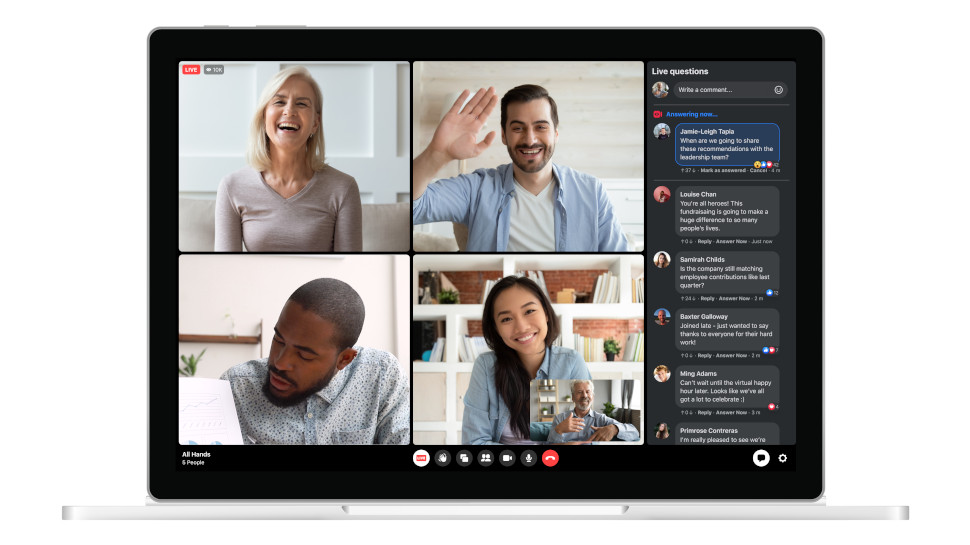Workplace from Facebook has a cunning plan to conquer the collaboration market
Facebook UI, features and infrastructure will drive Workplace to new heights

Workplace may be one of Facebook’s lesser-known offerings, competing for air-time with the likes of WhatsApp and Messenger, but the social media giant has big plans for its business collaboration platform.
While there are many rival offerings on the market (Slack, Teams, Asana etc.), all of whom will have had a stellar year thanks to the rise of remote working, Workplace is distinguished by its unique heritage, with roots in consumer social media.
In a lot of ways, using Workplace is exactly like browsing Facebook. And according to Ujjwal Singh, Head of Product Strategy at Workplace, this sense of familiarity is something the firm plans to further capitalize on this year.
- Here's our list of the best video conferencing services right now
- Working from home: the mouse, monitor, keyboard and router you need
- Check out our list of the best headsets for conference calls
“We are very much built in a similar way to Facebook. And that’s one of our core value propositions,” he told us. “People know what a ‘reaction’ is, what a ‘like’ is, what a ‘news feed’ is and they’ve seen people ‘go live’ on Facebook. So there isn’t a large learning curve associated with Workplace.”
“The stated mission of Facebook is to connect people and build community around the world. Applying that same mission to businesses is an interesting proposition - and it’s in our DNA.”
Asked whether he thought some people might baulk at the idea of spending their working days chained to an interface they associate naturally with play, he explained that Workplace is also very careful to set the proper boundaries.
Users do not log into Workplace with their consumer Facebook account, for instance, and nor do the two services share an application. Workplace leverages Facebook infrastructure, but is also at pains to stress that customers own their own data on the platform, which is not wholly true of the consumer service.
Sign up to the TechRadar Pro newsletter to get all the top news, opinion, features and guidance your business needs to succeed!
The key, Singh says, is in finding the right balance.
Facebook comes to Workplace
One of the main benefits of sitting underneath the Facebook umbrella is that features trialled, tested and perfected on the consumer platform tend to trickle down into the business service - and sometimes vice versa too.
“Any innovation on the consumer side we look to add into Workplace as well,” Singh explained. “It’s not about copying pixel by pixel from consumer, but more about hand-picking features and porting them over in a way that makes sense for work.”
As if to highlight this process in action, Workplace has today announced two new upgrades that are straight out of the Facebook playbook.
The first is a new multi-host option for the platform’s live broadcast feature, which has its origins in Facebook Live. Now, companies can broadcast to large audiences in a Q&A or panel discussion format, bringing in both internal and external speakers as “co-hosts” on screen without the need for a whole production team.
Facebook Live and its Workplace equivalent share the exact same underlying infrastructure, which means the latter is able to scale to the same heights as massive consumer-centric broadcasts. “For a big firm like Walmart to go company-wide is no problem for us, because on the consumer side we have Kim Kardashian broadcasting to her fans,” joked Singh, but his point is a serious one.

The second new addition is a feature that allows companies to take a register check of employees in the event of a safety incident, such as an office fire or virus outbreak. Since 2014, Facebook users have been able to “mark themselves as safe” in the aftermath of natural crises or terror incidents, and now the same is true of Workplace.
“No two safety incidents are the same. But if there’s one commonality, it’s the need for employers to be able to check on and clearly communicate with impacted employees quickly. New message types and multiple messages will enable organizations to better tailor their crisis response to the situation,” Workplace explained in a press release.
These new features, according to the company, are just a preview of what’s to come in 2021.
The future of work
With vaccine rollouts gathering steam, some will allow themselves to fantasize about a return to a working life that looks a little more like normality as we knew it pre-2020. But where might this leave the platforms that have risen from obscurity in the interim to become household names, in response to specific needs created by the pandemic?
Commentators are divided on the question; some believe the pandemic has had a transformative effect on the world of work, while others think we may look back on the period in a few years as if it were some awful dream.
As you might expect, however, Singh is confident of the long-term prospects of businesses like Workplace, which have so obviously gained from wholesale changes to ways of working.
“We’ve seen ten years of innovation and changes within one year, and that’s not going away,” he said.
“We continue to be excited about the mission of bringing people together and building company culture. Those needs might have been emphasized by the pandemic, but they’re going nowhere any time soon.”
- Check out our list of the best office desks and best office chairs for any budget

Joel Khalili is the News and Features Editor at TechRadar Pro, covering cybersecurity, data privacy, cloud, AI, blockchain, internet infrastructure, 5G, data storage and computing. He's responsible for curating our news content, as well as commissioning and producing features on the technologies that are transforming the way the world does business.